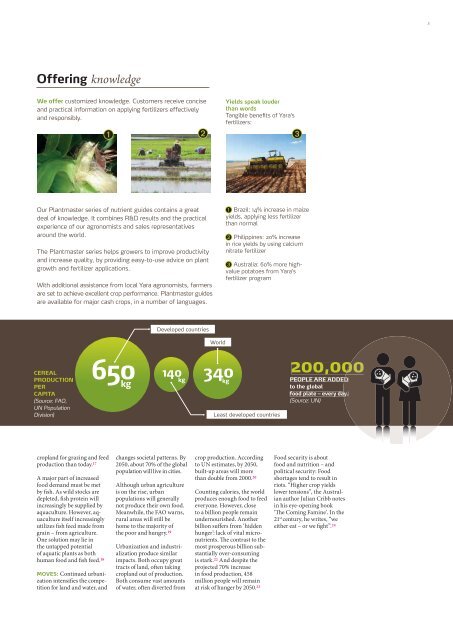Yara crop nutrition
Yara crop nutrition
Yara crop nutrition
You also want an ePaper? Increase the reach of your titles
YUMPU automatically turns print PDFs into web optimized ePapers that Google loves.
5<br />
Offering knowledge<br />
We offer customized knowledge. Customers receive concise<br />
and practical information on applying fertilizers effectively<br />
and responsibly.<br />
Yields speak louder<br />
than words<br />
Tangible benefits of <strong>Yara</strong>’s<br />
fertilizers:<br />
➊ ➋ ➌<br />
Our Plantmaster series of nutrient guides contains a great<br />
deal of knowledge. It combines R&D results and the practical<br />
experience of our agronomists and sales representatives<br />
around the world.<br />
The Plantmaster series helps growers to improve productivity<br />
and increase quality, by providing easy-to-use advice on plant<br />
growth and fertilizer applications.<br />
With additional assistance from local <strong>Yara</strong> agronomists, farmers<br />
are set to achieve excellent <strong>crop</strong> performance. Plantmaster guides<br />
are available for major cash <strong>crop</strong>s, in a number of languages.<br />
➊ Brazil: 14% increase in maize<br />
yields, applying less fertilizer<br />
than normal<br />
➋ Philippines: 20% increase<br />
in rice yields by using calcium<br />
nitrate fertilizer<br />
➌ Australia: 60% more highvalue<br />
potatoes from <strong>Yara</strong>’s<br />
fertilizer program<br />
Developed countries<br />
World<br />
CEREAL<br />
PRODUCTION<br />
PER<br />
CAPITA<br />
(Source: FAO,<br />
UN Population<br />
Division)<br />
650<br />
kg<br />
140<br />
kg<br />
340<br />
kg kg<br />
Least developed countries<br />
200,000<br />
PEOPLE ARE ADDED<br />
to the global<br />
food plate – every day.<br />
(Source: UN)<br />
<strong>crop</strong>land for grazing and feed<br />
production than today. 17<br />
A major part of increased<br />
food demand must be met<br />
by fish. As wild stocks are<br />
depleted, fish protein will<br />
increasingly be supplied by<br />
aquaculture. However, aquaculture<br />
itself increasingly<br />
utilizes fish feed made from<br />
grain – from agriculture.<br />
One solution may lie in<br />
the untapped potential<br />
of aquatic plants as both<br />
human food and fish feed. 18<br />
MOVES: Continued urbanization<br />
intensifies the competition<br />
for land and water, and<br />
changes societal pat terns. By<br />
2050, about 70% of the global<br />
population will live in cities.<br />
Although urban agriculture<br />
is on the rise, urban<br />
populations will generally<br />
not produce their own food.<br />
Meanwhile, the FAO warns,<br />
rural areas will still be<br />
home to the majority of<br />
the poor and hungry. 19<br />
Urbanization and industrialization<br />
produce similar<br />
impacts. Both occupy great<br />
tracts of land, often taking<br />
<strong>crop</strong>land out of production.<br />
Both consume vast amounts<br />
of water, often diverted from<br />
<strong>crop</strong> production. According<br />
to UN estimates, by 2050,<br />
built-up areas will more<br />
than double from 2000. 20<br />
Counting calories, the world<br />
produces enough food to feed<br />
everyone. However, close<br />
to a billion people remain<br />
undernourished. Another<br />
billion suffers from ‘hidden<br />
hunger’: lack of vital micronutrients.<br />
The contrast to the<br />
most prosperous billion substantially<br />
over-consuming<br />
is stark. 22 And despite the<br />
projected 70% increase<br />
in food production, 458<br />
million people will remain<br />
at risk of hunger by 2050. 23<br />
Food security is about<br />
food and <strong>nutrition</strong> – and<br />
poli tical security: Food<br />
shortages tend to result in<br />
riots. “Higher <strong>crop</strong> yields<br />
lower tensions”, the Australian<br />
author Julian Cribb notes<br />
in his eye-opening book<br />
‘The Coming Famine’. In the<br />
21 st century, he writes, “we<br />
either eat – or we fight”. 24



